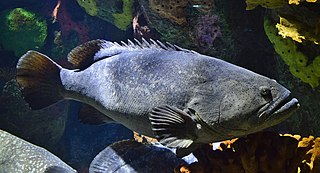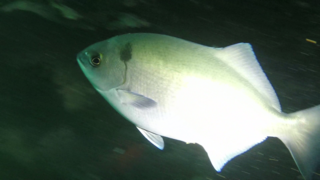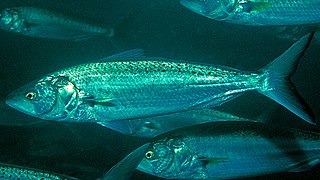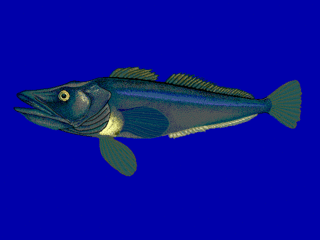
The black sea bass is a species of marine ray-finned fish, a sea bass from the subfamily Serraninae which is part of the family Serranidae, which also includes the groupers and anthias. It is found in the western Atlantic Ocean, where it is an important species for commercial and recreational fisheries.

Arripis is a genus of marine fishes from Australia and New Zealand, known as Australian salmon, kahawai and Australian herring. They are the only members of the family Arripidae. Despite the common name, Australian salmon are not related to the salmon family Salmonidae of the Northern Hemisphere, just as Australian herring are not related to herring of the Northern Hemisphere, but belong to the order Perciformes of perch-like fishes. Australian salmon were named so by early European settlers after their superficial resemblance to the salmoniform fishes.

The giant grouper, also known as the Queensland grouper, brindle grouper or mottled-brown sea bass, is a species of marine ray-finned fish, a grouper from the subfamily Epinephelinae which is part of the family Serranidae, which also includes the anthias and sea basses. It has a wide Indo-Pacific distribution and is one of the largest extant species of bony fish.

The halfmoon, also known as the blue perch, is a species of marine ray-finned fish, a sea chub from the subfamily Scorpidinae, part of the family Kyphosidae. It is native to the coasts of the eastern Pacific Ocean off western North America. It is fished for using hook and line and it is a desirable food fish.

The parore also known as luderick, black bream or blackfish is a species of marine ray-finned fish, a sea chub from the family Kyphosidae which is found in the southwestern Pacific Ocean off Australia and New Zealand. Parore or paraore is the common name in New Zealand but in Australia luderick is preferred.

Mycteroperca microlepis, the gag, gag grouper, velvet rockfish or charcoal belly, is a species of marine ray-finned fish, a grouper from the subfamily Epinephelinae which is part of the family Serranidae, which also includes the anthias and sea basses. It comes from warmer parts of the West Atlantic, including the Caribbean and Gulf of Mexico. It is a drab, mottled-gray fish lacking the distinguishing features of most other groupers. Its pattern of markings resemble the box-shaped spots of the black grouper. It lacks the streamer-points on the tail fin that scamp and yellowmouth grouper have, and lacks yellow coloration around the mouth.

Arripis trutta, known as kahawai in New Zealand and as the Australian salmon in Australia, is a South Pacific marine fish and one of the four extant species within the genus Arripis, native to the cooler waters around the southeastern Australian coasts and the New Zealand coastline. Other common names for this species include Eastern Australian salmon, bay trout, blackback salmon, buck salmon, cocky salmon, colonial salmon, newfish and salmon trout.

The yellowfin grouper is a species of marine ray-finned fish, a grouper from the subfamily Epinephelinae which is part of the family Serranidae, which also includes the anthias and sea basses. It is found in the warmer waters of the western Atlantic Ocean.
The tenspine grouper is a species of marine ray-finned fish, a grouper from the subfamily Epinephelinae which is part of the family Serranidae, which also includes the anthias and sea basses. It is found along the western coast of Mexico and Central America, but is a very rare fish of which little information exists.

Mycteroperca is a genus of marine ray-finned fish, groupers from the subfamily Epinephelinae, part of the family Serranidae, which also includes the anthias and sea basses. They are predatory fish, largely associated with reefs and are found in tropical and subtropical seas in the Atlantic Ocean and the eastern Pacific Ocean. They are important target species for fisheries.

The sailfin snapper, blue-lined sea bream or blue-lined sea perch is a species of marine ray-finned fish, a snapper belonging to the family Lutjanidae. It is native to the Indo-Pacific region. It is of minor importance to local commercial fisheries and can be found in the aquarium trade. It is currently the only known member of its genus.

The king threadfin, also known as the blind salmon, blink tassel-fish, burnett salmon, gold threadfin, king salmon, kingfish, Sheridan threadfin, triped tassel fish, or threadfin salmon, is a species of marine ray-finned fish, a threadfin from the family Polynemidae which is found in southern New Guinea and northern Australia.

The redmouth grouper, also known as the red-flushed rock cod is a species of ray-finned fish, a grouper from the subfamily Epinephelinae which is part of the family Serranidae, which also includes the anthias and sea basses. It has a wide distribution in the Indian and Pacific Oceans. It is considered a game fish.

Pseudochaenichthys is a monotypic genus of marine ray-finned fish belonging to the family Channichthyidae, the crocodile icefishes. Its only member is Pseudochaenichthys georgianus, the South Georgia icefish, which is found in the Southern Ocean.

Caesio caerulaurea, the blue and gold fusilier, blue fusilier, gold-band fusilier or scissor-tailed fusilier, is a species of marine fish in the family Caesionidae. It is widespread throughout the tropical waters of the Indo-Pacific area, including the Red Sea.
The dara is a species of marine ray-finned fish, a grunt belonging to the family Haemulidae. It is native to the Atlantic coast of Africa. It is the only species in the monospecific genus Parakuhlia.

Arripis truttacea, the Western Australian salmon, is a species of marine ray-finned fish within the genus Arripis, the only genus within the family Arripidae. It is endemic to the seas off southern Australia.
Arripis xylabion, the giant kahawai, northern kahawai or Kermadec kahawai, is a species of marine ray-finned fish, one of the four species in the genus Arripis, which is the only genus in the family Arripidae. It is endemic to the south-western Pacific Ocean.

The sea trumpeter is a species of marine ray-finned fish, a grunter from the family Terapontidae. It is endemic to the southeastern Indian Ocean off the southwestern coats of Australia.

Pomadasys argenteus, the silver grunt, silver javelin, grunter bream, small-spotted grunter-bream, small-spotted javelin fish, trumpeter or white-finned javelin fish, is a species of marine ray-finned fish, a grunt from the family Haemulidae. This species has a wide Indo-Pacific distribution. It is the type species of the genus Pomadasys.

















